February 12-15, 2018 - Orlando, Florida
Digital Transformation and Open Process Automation Take Center Stage
ARC Advisory Group’s 22nd Annual Industry Forum saw record attendance, with more than 920 attendees from 350 different companies and 25 countries. This year’s Forum featured six different dedicated tracks, 48 sessions, and 180 executive speakers.
The keynote addresses included well-received presentations by Kenny Warren from ExxonMobil Research & Engineering and Jason Handley from Duke Energy. Mr. Warren provided an update on the Open Process Automation (OPA) initiative and Mr. Handley discussed his company’s ongoing smart grid initiative to help enable it to become more customer-centric. ARC’s Andy Chatha then provided a thought-provoking perspective on related technology trends, including platforms for digital transformation.
These three keynotes on Tuesday were preceded by a full-day of well-attended workshops on industrial cybersecurity and asset performance management, major press announcements by Forum sponsors, and the inaugural meeting of the end user Digital Transformation Council, which drew more than 70 end users from many different operating companies.
Update on Open Process Automation
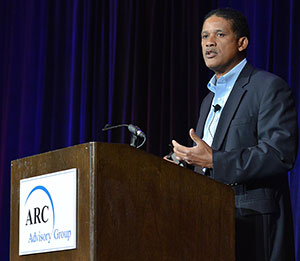 Kenny Warren, Vice President of Engineering at ExxonMobil Research & Engineering, began his keynote address with a quote from Steve Jobs: “Innovation distinguishes between a leader and a follower.” This relates to the company’s efforts to encourage innovation in engineering and provides insight into why ExxonMobil initiated the bold attempt to upend the industrial automation space with the Open Process Automation (OPA) initiative, first announced at the 2017 ARC Industry Forum in Orlando.
Kenny Warren, Vice President of Engineering at ExxonMobil Research & Engineering, began his keynote address with a quote from Steve Jobs: “Innovation distinguishes between a leader and a follower.” This relates to the company’s efforts to encourage innovation in engineering and provides insight into why ExxonMobil initiated the bold attempt to upend the industrial automation space with the Open Process Automation (OPA) initiative, first announced at the 2017 ARC Industry Forum in Orlando.
Mr. Warren followed this up with his own observation: “You never know where technology is going to lead you.” Here, he used the example of the iPhone, which began life as a very cool smartphone for consumers, but has evolved into a powerful hand-held application platform for all, including business and industry.
Next, he reiterated the vision for OPA as a standards-based, open, interoperable and secure process automation architecture, commercially available to all companies. He then explained the status of the three related activity tracks: 1. Develop a proof-of-concept, 2. Adopt appropriate industry standards, and 3. Collaboratively develop solutions and perform field trials.
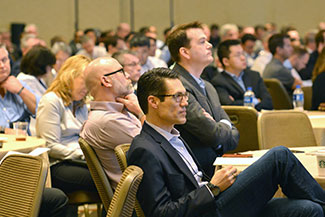 Of these, the proof-of- concept prototype work performed under contract with Lockheed Martin became operational in September 2017 is now entering the final testing stage (Forum attendees got a peek at this POC in a later session). Industry standards have been identified by the Open Process Automation Forum (OPAF) under the auspices of The Open Group. OPAF has grown to 17 major operating companies and almost 60 suppliers, SIs, and “Others” (such as ARC). Finally, we learned that the collaborative development and parallel field trial track will kick off later in 2018.
Of these, the proof-of- concept prototype work performed under contract with Lockheed Martin became operational in September 2017 is now entering the final testing stage (Forum attendees got a peek at this POC in a later session). Industry standards have been identified by the Open Process Automation Forum (OPAF) under the auspices of The Open Group. OPAF has grown to 17 major operating companies and almost 60 suppliers, SIs, and “Others” (such as ARC). Finally, we learned that the collaborative development and parallel field trial track will kick off later in 2018.
According to Mr. Warren, the aim is to have the system technically ready for on-process use in 2021. Next, he explained why this initiative is important to ExxonMobil (and, by extension, to many other operating companies). “We want and need to innovate our business and plant floor operations with digital technologies.” As we learned, it’s becoming increasingly critical for ExxonMobil to better leverage the huge amount of data being collected to improve analytics, identify and monetize opportunities, develop a consistent approach across time frames, and implement a common computing and visualization platform across its global fleet of assets. Mr. Warren continued, “We have a one-time opportunity to make a step change in our business. The imperative now is to increase productivity and customer satisfaction. Closed, proprietary industrial control systems have served us well until now, but the future will be more IIoT-like with more open and interoperable systems.”
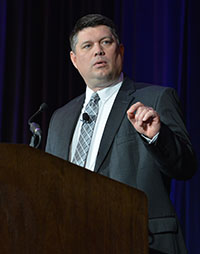 Duke Energy’s “Road Ahead” to the Digitally Enabled Smart Grid
Duke Energy’s “Road Ahead” to the Digitally Enabled Smart Grid
Jason Handley, Director, Smart Grid Emerging Technology and Operations at Duke Energy, gave the next keynote address. Duke Energy has long been a leader in the utility industry. Today, it serves 7.5 million electric customers and 1.6 million natural gas customers in six states. Mr. Handley shared the company’s strategic vision to achieve top quartile performance in customer satisfaction over the next decade. Under the company’s “Road Ahead” program, it is investing $25 billion in energy grid modernization and $11 billion in cleaner generation, and plans to expand its natural gas infrastructure to be able to almost double its current business mix from gas…all within ten years.
Mr. Handley summarized some of the challenges Duke Energy faces:
- Customers want choice and control, regardless of market structure
- Increased penetration of distributed energy resources (DERs) will drive the need for grid edge intelligence
- IoT drives connectivity to all “things” (utility- and customer-owned)
- Flat-to-declining load growth in regulated service area due to DERs and energy efficiency improvements
- Shift to more distributed functions and advanced analytics
- Heightened need for cybersecurity and privacy
He explained that the company will need to develop ways to deliver on customers’ wants and desires to create a “motivating customer experience.” To this end, customer-centric initiatives include things like implementing mechanisms to support flexible bill due dates, pre-pay programs, alerts, digital engagement, recognizing customer milestones, and individualized offers. The company believes that, through more frequent customer interactions, it can ultimately develop a relationship that goes deeper than just price. In just one example of the move toward a more customer-centric mindset, the company no longer refers to its customers as “ratepayers.”
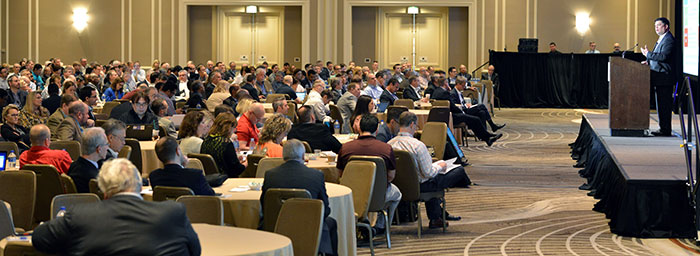
According to Mr. Handley, the utility industry is moving from a period of steady linear progression to one of “hairball” complexity. Since variable generation resources (solar, wind, etc.) don’t work well on today’s grid, smart grids will be needed. “Tomorrow’s grid will generate a large volume of data and different data types, including data from new assets that the utility may or may not own. Decision making will have to be both centralized and distributed, with more distributed intelligence and control,” Mr. Handley explained. “We’ll have to move to self-healing and self- optimizing grids and we’ll also have to operate in an [environmentally] sustainable manner.” Tomorrow’s grid will be a conglomeration of multiple generation sources from Duke Energy and others engaging in millions of energy transactions per second in a new peer-to-peer energy economy.
Digital Platforms, a New Approach to Software
In his role as ARC Advisory Group’s Founder & CEO, Andy Chatha serves as a technology visionary for the entire industry. He constantly monitors the overall technology landscape to identify and zero in on new technologies and approaches that can advance innovation for industry and infrastructure. In recent years, this has also extended to new technologies and approaches for smart cities and smart transportation networks.
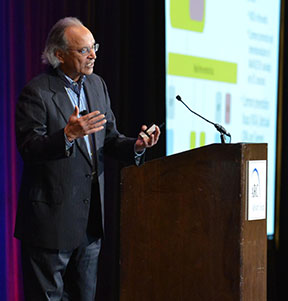 In his keynote address at this year’s ARC Industry Forum, Andy focused on the new open and secure hardware and software platforms that will play an increasingly important enabling role within a successful digital enterprise.
In his keynote address at this year’s ARC Industry Forum, Andy focused on the new open and secure hardware and software platforms that will play an increasingly important enabling role within a successful digital enterprise.
“As software companies are moving their applications to the cloud, they are moving to a new architecture that we call ‘digital platforms,’ on top of which you can configure or develop small apps or microservices, small, loosely coupled applications that do one thing well,” Andy explained.
Most enterprises today are already using major applications or platforms such as enterprise resource planning (ERP), supply chain management (SCM), customer relationship management (CRM), manufacturing execution systems (MES), and automation. But, as Andy explained, as companies, municipalities, and transportation networks become digital enterprises, they will need a few more digital platforms, including platforms to support the Internet of Things (IoT).
“Many companies today have platforms for connecting devices. Some of you have thousands of measurement and control devices. Many of these are connected to your control or automation system, but a majority of them are for monitoring purposes. You may want to connect these to a separate IoT device platform, because connecting a monitoring device to a control system can be expensive.” This platform can sit in your plant alongside your automation system in a device such as an edge gateway.
Andy moved on to his discussion of cloud computing platforms, also referred to as Infrastructure as a Service (IaaS). The main cloud compute or infrastructure platforms provide the basic computing and storage capabilities. And you build your apps on top of these. “Once you move all the data to the cloud, you want to analyze it, so you will need an analytics and machine learning engine,” explained Andy. “There are several hundred potential suppliers in this space, but only nine major ones. As end users, your challenge is to pick the one that is most suitable for your applications.”
Executive Panel Discussion
Following these three keynote addresses, Andy invited senior executives from ABB, AspenTech, and Schneider Electric to say a few words about how their respective companies are addressing these key issues before participating in a panel discussion with the keynote presenters. Peter Terwiesch, President of the ABB Industrial Automation Division, discussed how the company is working to digitally transform itself and its customers; Antonio Pietri, President and CEO of AspenTech discussed the potential benefits and some potential pitfalls of digital transformation; and Peter Herweck, Executive Vice President at Schneider Electric discussed how energy management and automation are coming together.
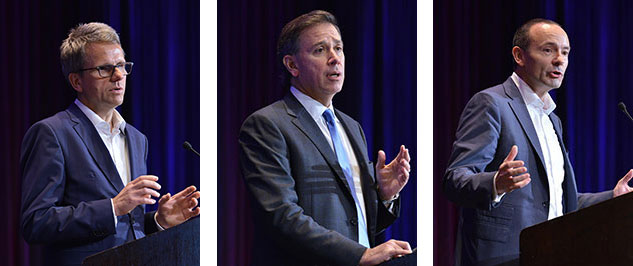
The panelists then addressed some pointed questions from both Andy and the audience, including their thoughts on the OPA initiative. Following the panel discussion, everyone adjourned for a buffet lunch outside at the Renaissance Hotel’s inviting pool area. This was followed by three full days of topical sessions and networking opportunities, including an enjoyable Wednesday evening reception at nearby SeaWorld Discovery Cove, hosted by Microsoft, just one of the Forum’s many corporate, association, and media sponsors.
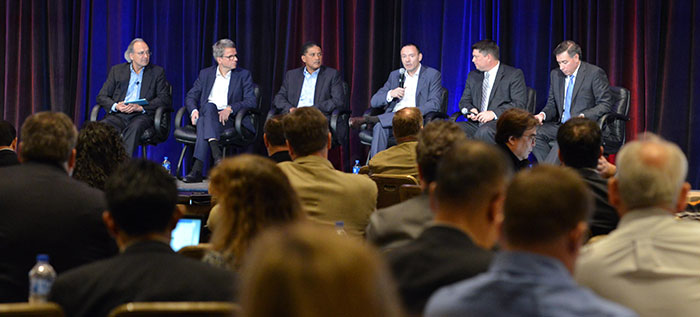
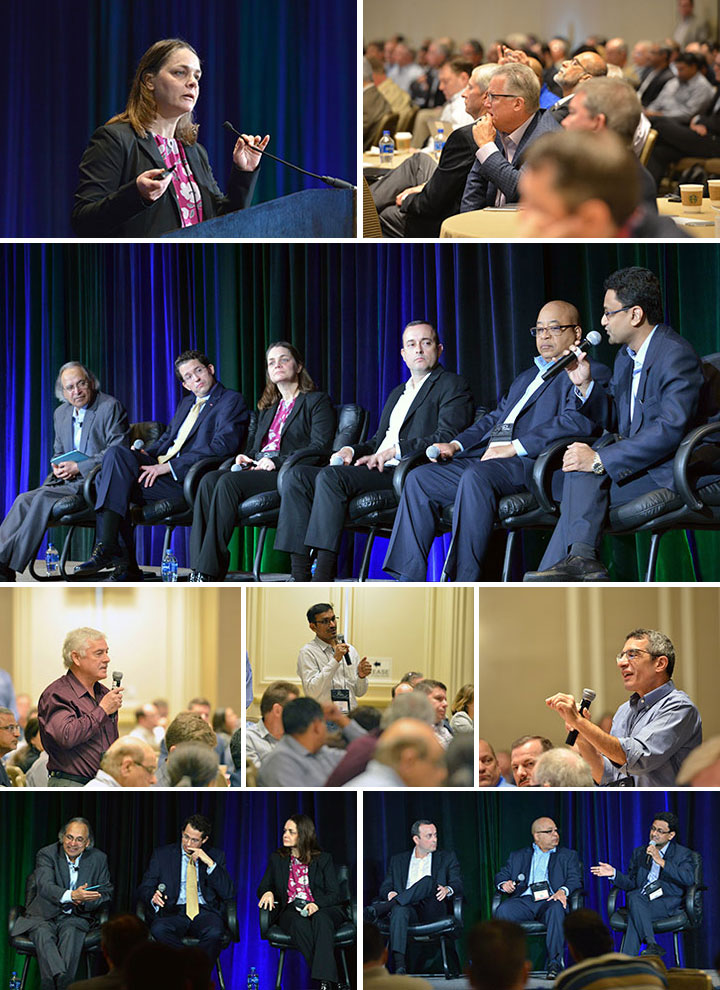
Most industrial companies still tend to make decisions based on habitual ways of doing things, tribal knowledge, rules-of-thumb, and the opinions of in-house experts. But leading companies are moving to an information-driven culture and business model in which all decisions are made based on analysis of operations and business process data. Throughout the organization, these companies employ software to collect, contextualize, visualize, and analyze data to gain new insights. The common question is, “What does the data tell us?” Armed with new insights, organizations can anticipate changes and drive better business results.
It is clear that the use of analytics in industrial companies is growing rapidly. With the industrial space becoming much more dynamic, manufacturers are turning to advanced analytics and machine learning to support predictive and prescriptive solutions. More companies are pursuing analytics solutions and more employees throughout the enterprise want more and better decision tools. And the increasing focus on Smart Manufacturing, Industrie 4.0 (I4.0), and Industrial Internet of Things (IIoT) is driving demand for predictive maintenance and operating performance improvement solutions, which rely on advanced analytics.
This program will:
- Cut through the confusion surrounding 'analytics' in the industrial space
- Provide a useful conceptual framework for differentiating modern analytics platforms from previous approaches
- Highlight new technologies, platforms, architectures, and processes
- Present case studies and examples from early adopters of new analytics systems
- Provide industrial companies the information they need to begin their own analytics journey
Asset Performance Management 2.0 now incorporates Industrial IoT (IIoT) and new analytics solutions like machine learning. It uses information from production management, control systems, and asset management applications to provide new opportunities to optimize asset availability and operational performance. This optimization goes beyond functional silos and occurs between silos where significant inefficiency, waste, and sometimes dysfunction often reside.
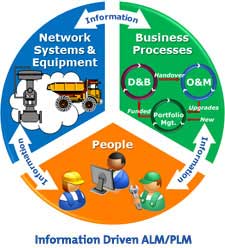 Balancing the objectives of operations for on-time delivery, volume, and quality with those of maintenance for asset availability, longevity, and reliability requires sharing information and harmonizing these objectives with the goals of the enterprise. New information technologies provide functionality to intensify cross-functional collaboration, business process improvements, and higher levels of performance to achieve asset lifecycle management (ALM) excellence.
Balancing the objectives of operations for on-time delivery, volume, and quality with those of maintenance for asset availability, longevity, and reliability requires sharing information and harmonizing these objectives with the goals of the enterprise. New information technologies provide functionality to intensify cross-functional collaboration, business process improvements, and higher levels of performance to achieve asset lifecycle management (ALM) excellence.
The ability to interact with equipment – like a variety of devices on a single site, or widely dispersed machines – presents new opportunities for industrial companies, utilities, and equipment suppliers. These networks provide a new “connected ecosystem” of equipment manufacturers, systems integrators, and end users. Some manufacturers and utilities have begun adopting these technologies.
Those attending this ALM program will learn what was successful, and gain insights into what is next. The objective is to make fact-based decisions using reliable information that aligns with the organization’s objectives. An ALM strategy helps ensure the best possible returns on capital investments over the lifecycle of the asset. If you are involved in operations, maintenance, or industrial IT, you will want to attend these program sessions.
We have entered a period of intense innovation in industrial automation. In the areas of high value-added manufacturing there is growing global competition. Countries with developed economies want to maintain and grow their existing competitive advantages and support their exporting industries. Countries with developing economies want to improve their competitiveness as well.
This competition is, in part, taking the form of national initiatives to improve manufacturing competitiveness. These initiatives are found in Germany, the US, Japan, Korea, and China. In the US the Industrial Internet Consortium has formed. Platform Industrie 4.0 is the German initiative; the “4.0” referring to a 4th industrial revolution (following steam, mass production, and IT). This can be thought of as a set of new technologies that are fusing the physical, digital, and biological worlds, and impacting all disciplines, economies and industries.
Some of the topics that will be covered in the sessions for this program include:
FDI, OPC UA, and Ethernet for Process Field Devices
The FieldComm Group and the OPC Foundation will explain and demonstrate their newest technologies for process automation. This will be a multi-vendor/multi‐protocol device-to-cloud demonstration of both FDI and OPC UA. Also, as part of a new supplier consortium, FieldComm Group will explain its conformance program for devices that will use the future 2‐wire Ethernet standard now in development by the IEEE 802.3cg committee. This 2019 standard will enable high speed communication to process field devices over distances as long as 1 kM.
The Open Process Automation Forum: The Latest Update
The Open Group’s Open Process Automation Forum is noteworthy for several reasons. First, because of its genesis within ExxonMobil, a leading international oil company with a long reputation for operational excellence. Second, because the products of this program will be technologically quite different from the process automation systems used today. Third, because the value chain envisioned for this program is also quite different from the way the process automation market works today. The latest developments in this initiative will be presented and discussed.
Industrial Automation and the Industrie 4.0/Industrial Internet Initiatives
What will be the impact on manufacturing and automation of these major national initiatives? How will the process industries, discrete manufacturers, and automation suppliers adapt and change their products in response to these programs? What are thought leaders in Europe and North America doing now and planning for the next few years?
TSN, OPC UA, and Future Industrial Automation
Time Sensitive Networking, or TSN, carries huge implications for industrial automation, for existing industrial Ethernet protocols, as well as for OPC UA and for all types of industrial middleware. TSN is an effort to bring much higher and more adjustable quality of service to standardized networks. TSN is needed for “network convergence”; when a single physical network replaces multiple dedicated-function networks. In such cases, network traffic needs to be managed so that the applications using the single converged network continue to experience their normal quality of service. Where are the biggest cases for network convergence today? The largest unit volume opportunity is for converged networks in automotive on-car applications for future smart and autonomous cars and in industrial automation.
Industrial Software Defined Networks
Technologies of software-defined networking (SDN) that have recently been applied in actual industrial control systems are quite promising in that they may deliver substantial improvements in the properties of networks of both new and existing industrial control systems and IIoT infrastructure. These networks promise greater security, performance, and even ease of device mobility. ARC plans to have several end users report on their experiences.
The concept of a smart city is not new, but it is still nascent and the definition remains quite heterogeneous. Broadly, a smart city is connected, intelligent, and optimized by a municipality to reduce costs, increase safety, attract investment, be sustainable, and enhance livability. To get there will require smart governance, the education of a smart workforce and smart citizens, the digital transformation of assets, and the deployment of sensor networks with ubiquitous multimodal connectivity.
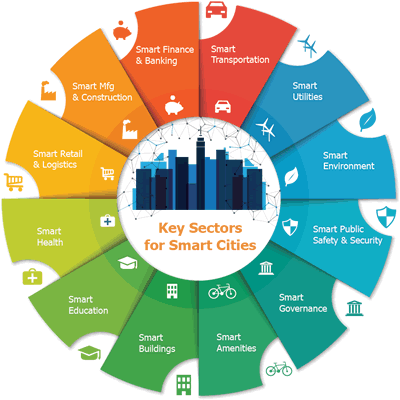 As computing power, bandwidth, and the cost of microprocessor electronics and sensors all approach zero, the ability for municipalities to deploy massive wide-area networks of intelligent devices is slowly becoming reality. Smart cities present tremendous opportunities for industrial IoT vendors, but the technical challenges, vast number of players in this ecosystem, and the fact that it bridges private, public, and consumer realms makes navigating and succeeding in this market a challenge. Cybersecurity, connectivity, and working with municipal bureaucracy remain the biggest challenges, but other obstacles include exponential data volume growth, data cleansing speed, the need to go from cloud to edge architectures, quantifying results, interoperability, and human fears/resistance to transformational change such as AI.
As computing power, bandwidth, and the cost of microprocessor electronics and sensors all approach zero, the ability for municipalities to deploy massive wide-area networks of intelligent devices is slowly becoming reality. Smart cities present tremendous opportunities for industrial IoT vendors, but the technical challenges, vast number of players in this ecosystem, and the fact that it bridges private, public, and consumer realms makes navigating and succeeding in this market a challenge. Cybersecurity, connectivity, and working with municipal bureaucracy remain the biggest challenges, but other obstacles include exponential data volume growth, data cleansing speed, the need to go from cloud to edge architectures, quantifying results, interoperability, and human fears/resistance to transformational change such as AI.
ARC has identified 12 key smart city application sectors: Smart Transportation, Smart Utilities, Smart Environment, Smart Public Safety and Security, Smart Governance, Smart Buildings, Smart Education, Smart Health, Smart Retail and Logistics, Smart Manufacturing and Construction, Smart Finance and Banking, and Smart Amenities. This program will feature expert panels and case study presentations showcasing successful deployments of key smart city IIoT technologies. Topics for discussion include:
- Cyber-secure smart city ecosystems
- Smart utilities: Self-healing grids and smart water networks
- Intelligent transportation and traffic systems
- Moving from centralized to edge architectures
- Lighting networks as the IoT backbone for smart cities and buildings
- Advanced visualization including Digital Twin & AR/MR/VR platforms for cities and buildings
- Machine learning and artificial intelligence for cities and buildings
- Leading-edge enablement technologies such as SD-WAN, HD video analytics, and extreme data processing at the edge
Autonomy and intelligence embedded pervasively in automation equipment is one of the key attributes to realization of connected smart machinery. Connected smart machinery is important in virtually every application imaginable, but is even more valuable in cases where there is limited communications. Machinery that analyzes and compresses large data sets are essential to ensuring that the data traffic on the Internet does not overwhelm the system or data can be analyzed local to the device. The connected smart machine will require not just more sensors, but also more intelligent sensors. Sensors must perform more sophisticated signal processing “at the edge” to provide accurate signals that filter out the noise before it gets to the automation system.
In this program, machine builders employing intelligent sensors into the machinery to perform complex condition monitoring algorithms into automation systems will be highlighted. Key topics for discussion include:
- Creating new maintenance service revenue streams for machine builders
- Development of equipment protection algorithms that increase resilience of machinery to stay operational for much longer periods of time.
- Adaptive control algorithms allowing systems to operate over a wider range.
- Predictive condition monitoring systems that use real-time control algorithms to provide a new level of maintenance information.
- Exploring the potential of the Industrial Internet of Things (IIoT) to combine the benefits of multivariate analysis, predictive modeling, and inferential information to preempt abnormal situations.
Challenges continue to grow for the industrial cybersecurity community. Broader deployment of operational technology is expanding the use cases requiring protection. Resource shortages are undermining the effectiveness of established defenses. Blurring boundaries between IT, OT and IoT are increasing the need for more integrated, collaborative cybersecurity strategies.
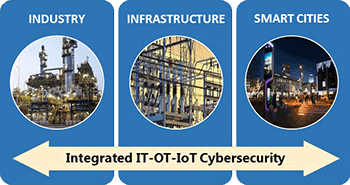 Industrial plants and infrastructure systems need secure control systems to ensure safe, reliable operation. Widespread use of operational technologies in smart cities presents a similar challenge. Compromised systems jeopardize citizen safety, business continuity, and effective delivery of critical government services like water and sewage. To avoid such incidents, smart city planners need people who understand operational technology and the associated security challenges. Leveraging the experiences of the industrial cybersecurity community is essential.
Industrial plants and infrastructure systems need secure control systems to ensure safe, reliable operation. Widespread use of operational technologies in smart cities presents a similar challenge. Compromised systems jeopardize citizen safety, business continuity, and effective delivery of critical government services like water and sewage. To avoid such incidents, smart city planners need people who understand operational technology and the associated security challenges. Leveraging the experiences of the industrial cybersecurity community is essential.
Cybersecurity challenges are also increasing within traditional plants and infrastructure systems. Many plants still lack the resources to sustain defenses or proper strategies to enable external support. Deployment of IIoT strategies is proceeding without real solutions for critical issues like secure-by-design-devices and secure supply/support chains. Growing use of cloud-based solutions are undermining the ability of in-house teams to govern security practices. Segregating cybersecurity efforts by technology is no longer a sustainable approach. Organizations need to develop new integrated strategies that combine IT, OT, and IoT security efforts and maximize use of all corporate cybersecurity resources.
ARC’s Cybersecurity program explores these issues through informative workshops, panel discussions, and case study presentations. It is the ideal venue to learn what others are doing, how they are doing it, and the benefits they are achieving. Attendees also have ample opportunities to discuss their unique challenges with peers, researchers, educators, service providers, and solution providers.
This program is unique. Other conferences discuss cybersecurity from a single perspective, like IT or OT. ARC’s program is the only event that brings together people who understand all the cybersecurity challenges of industry, infrastructure, and smart city organizations. Attendees leave armed with the information they need to make significant improvements in their cybersecurity programs.
Stakeholders in IT, automation, operations, safety, product development, business improvement, and city planning efforts can all benefit from this program. They will gain a solid understanding of the challenges and the actions needed to avoid major cybersecurity incidents.
Industrial Internet platforms are emerging as pivotal, value-added components of the Industrial Internet of Things (IIoT) architecture. These platforms add incremental value by functioning not only as the glue linking connected industrial devices to higher level performance-enhancing applications, but also as the execution environment for the applications themselves.
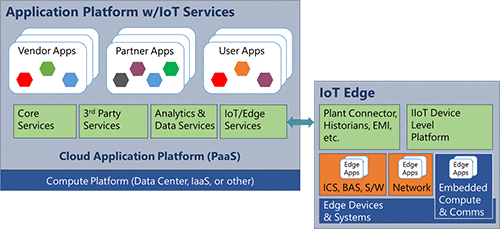 Industrial Internet platforms play an integral role in analytics, big data, remote asset monitoring, performance management, decision support, universal visualization, and the value chains for connected products and products-as-a-service. The ability of these applications to access, analyze, and process industrial data is central to the IIoT value proposition.
Industrial Internet platforms play an integral role in analytics, big data, remote asset monitoring, performance management, decision support, universal visualization, and the value chains for connected products and products-as-a-service. The ability of these applications to access, analyze, and process industrial data is central to the IIoT value proposition.
Industrial Internet platforms architecturally reside between intelligent devices and higher levels of the enterprise architecture. Device connectivity platforms monitor, collect, process, and transmit data from a variety of intelligent sensors, devices, machines, products, and other assets to higher levels of the architecture, while analytics, big data, machine learning, and numerous other applications that deliver incremental process improvements typically reside in enterprise-level platforms.
This program will look at the central role of Industrial Internet platforms in the emerging Industrial Internet of Things and how to use them to achieve incremental business benefit.
The IoT network edge has emerged as a primary vehicle for delivering incremental business value via internet-enabled business strategies such as the Industrial Internet of Things (IIoT), Industrie 4.0 (I4.0), and Smart Cities and Infrastructure.
Escalating demands to feed information from data-rich intelligent edge devices to the cloud is one of the most pressing issues facing OT and IT professionals in the era of internet-enabled business strategies. Standard options include support of common API or protocols, but cloud-based agents themselves are migrating into network edge devices. These agents are increasingly viewed as not only vehicles for closer edge-to-cloud integration, but also as platforms for edge computing applications that execute locally, offloading processing from the cloud and providing enhanced security and closer to real time performance.
This program will highlight current and prospective demands on both network edge infrastructure, such as gateways, routers, and switches, as well as smart end devices that function as edge nodes in the IoT architecture. In addition, this program will focus on edge to cloud integration options with an emphasis on embedded cloud integration and edge computing.
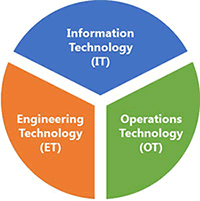 An important enabler for innovation in industrial companies is the convergence of IT (Information Technology at the enterprise level), OT (Operations Technology, the information and automation technologies employed in the plant), and ET (Engineering Technology, the newer technologies that create virtual models). IT/OT/ET convergence is among the drivers of the digital transformation that leading companies are embarking upon. A wide range of technologies, such as Ethernet/Wi-Fi, virtualization, cloud, SaaS, analytics, Big Data, mobile, social, modeling, augmented reality, machine learning, remote monitoring, and digital twin are now being employed in industrial operations to improve operating performance, create a virtual environment, or introduce the Industrial Internet of Things. But the big payoff comes when companies begin to operate in new, collaborative ways across the whole of the enterprise.
An important enabler for innovation in industrial companies is the convergence of IT (Information Technology at the enterprise level), OT (Operations Technology, the information and automation technologies employed in the plant), and ET (Engineering Technology, the newer technologies that create virtual models). IT/OT/ET convergence is among the drivers of the digital transformation that leading companies are embarking upon. A wide range of technologies, such as Ethernet/Wi-Fi, virtualization, cloud, SaaS, analytics, Big Data, mobile, social, modeling, augmented reality, machine learning, remote monitoring, and digital twin are now being employed in industrial operations to improve operating performance, create a virtual environment, or introduce the Industrial Internet of Things. But the big payoff comes when companies begin to operate in new, collaborative ways across the whole of the enterprise.
This program features speakers talking about how they utilized the IT/OT/ET enablers of digitization and innovation to improve performance in their production operations and throughout their organizations.
It was an honor and pleasure to be invited to speak at the ARC event. I was impressed with the level of knowledge I was exposed to at this conference; this will become an annual event for me. A sincere thank you to ARC for organizing a "WOW" event in 2018.
Marty Martin
Director, Process Control Technology

ARC Advisory Group industry events are extremely valuable (to Saudi Aramco). ARC is the barometer for our industry.
Abdullah Al-Khalifah
Senior Engineering Consultant

I found the presentation tracks [at ARC Industry Forum 2018] extremely valuable and I’ve already made some requests within Biogen to bring a greater presence next year. I look forward to returning!
Matt Willert
Automation Engineer

It was a high honor for me to participate [at ARC Industry Forum 2018] on behalf of the City of Orlando!
Charles Ramdatt
Director, Smart Cities and Special Projects

Client Testimonials
Featured Keynote Speakers
The following executives gave the Forum's Keynote Presentations.
Kenny Warren
 Vice President of Engineering
Vice President of Engineering
ExxonMobil Research & Engineering
Kenny oversees a global engineering organization – with offices in Texas, Singapore, Malaysia, Canada, and the UK – that provide support to ExxonMobil refineries and chemical plants worldwide. Part of that organization’s role is supporting new technology deployment for both plant automation and equipment. Kenny has over 37 years with ExxonMobil and has held various technical, supervisory and managerial positions in refining, supply, and fuels and lubes marketing working in Texas, Illinois, Virginia, and Brussels.
Jason Handley
 Director, Smart Grid Emerging Technology and Operations
Director, Smart Grid Emerging Technology and Operations
Duke Energy
Jason is a respected utility industry professional with over 20 years of experience specializing in smart grid, distributed Intelligence, and operations management. He excels at understanding the increasingly complex utility environment, managing the new digital utility workforce, and delivering on the execution and financials of technology projects. In his current role, Jason identifies and develops new technologies impacting the electrical grid and oversees all of the ongoing operational aspects on new technology pilot projects in Duke Energy’s Smart Grid Emerging Technology group. He has been a strong advocate for grid edge computing, the new OpenFMB™ architecture for machine to machine data exchange, and building in cybersecurity measures into grid edge devices. He and his team are responsible for developing and updating the strategic roadmap for power grid devices and communications at Duke Energy. In addition to serving on the NIST Smart Grid Advisory Committee, Jason served as the Chairman of EPRI’s IntelligGrid Program Advisory Committee P161, the Board of Directors for the Smart Grid Interoperability Panel and continues to serve on numerous committees including the SAS Utility Advisory Board and the DistribuTECH Advisory Committee.
Monday, February 12 - Pre-Forum Workshops
| 8:30 AM | Workshop Sessions |
| 10:00 AM | Break |
| 10:30 AM | Workshop Sessions |
| 2:00 PM | Workshop Sessions |
| 3:30 PM | Break |
| 4:00 PM | Workshop Sessions |
| 6:00 PM | Welcome Reception |
Tuesday, February 13
| 8:30 AM | Keynote Presentations |
| 10:00 AM | Break |
| 10:30 AM | Executive Panel |
| 12:00 PM | Lunch |
| 2:00 PM | Concurrent Track Sessions |
| 3:30 PM | Break |
| 4:00 PM | Concurrent Track Sessions |
| 6:00 PM | Evening Reception |
Wednesday, February 14
| 8:30 AM | Keynote and Executive Panel |
| 10:00 AM | Break |
| 10:30 AM | Concurrent Track Sessions |
| 12:00 PM | Lunch |
| 2:00 PM | Concurrent Track Sessions |
| 3:30 PM | Break |
| 4:00 PM | Concurrent Track Sessions |
| 6:00 PM | Evening Reception |
Thursday, February 15
| 8:30 AM | Concurrent Track Sessions |
| 10:00 AM | Break |
| 10:30 AM | Concurrent Track Sessions |
| 12:00 PM | Forum Ends with Boxed Lunches |
Innovations Showcase
New industry solutions are on display at the Innovations Showcase. The Showcase provides an excellent opportunity for executives to assess the potential for emerging applications in production management, interoperability, virtual manufacturing, process improvement, asset management, operations management, supply chain synchronization, and more. Exhibits have application scenarios for attendees to see how emerging technologies are applied to help solve issues across all industries.
The Showcase is open during the Monday Evening Reception and during breakfasts, breaks, and lunches. It is held adjacent to the forum where refreshments are served.
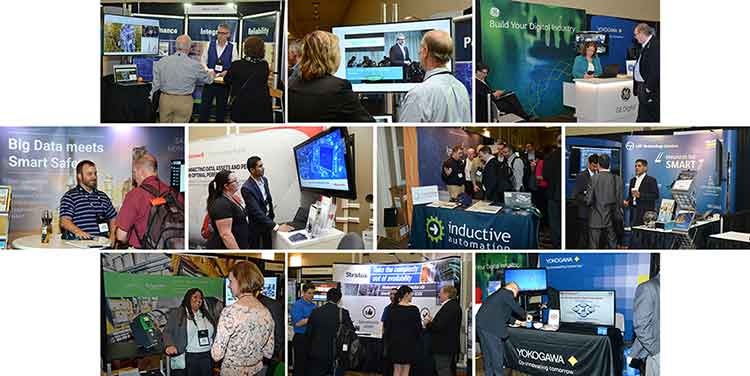
Location
 The Forum is held at the Renaissance Orlando Hotel in Orlando, Florida.
The Forum is held at the Renaissance Orlando Hotel in Orlando, Florida.
Renaissance Orlando at SeaWorld
6677 Sea Harbor Drive
Orlando, Florida 32821
renaissanceseaworldorlando.com
The Renaissance is just a short shuttle or taxi ride from the most popular Orlando attractions and within easy access of Orlando airports. Hotel amenities include complimentary 24 hour fitness center use; transportation to SeaWorld Orlando, Discovery Cove, Aquatica, and Universal Studios Orlando based on shuttle schedule; and public area wireless Internet.
Orlando Visiting Information
Please contact Orlando's Visitor Information Center at 407-363-5874, www.visitorlando.com, for information regarding current events in Orlando. For discounted attractions in Orlando, please visit Orlando Convention Aid website. Their on-line travel guide offers discounts to restaurants, golf, attractions, nightlife, shopping, and more, including making dinner reservations for you.
Previous Attendees
The following companies have attended recent ARC forums:
Aerotech
Agilent Technologies
Air Liquide
Akzo Nobel
Alliance Pipeline
AMEC Natural Resources
Anglo American
Archer Daniels Midland
Areva
Axiall
Azbil
Baker Hughes
Beckhoff Automation
BHP Billiton
Blackrock
BorgWarner
Bosch Rexroth
Brady
C-Labs
Cal-Amp
Cambell Soup
Cenovus Energy
CF Industries
China Yangzte Power
Church & Dwight
Comau
Connacher Oil and Gas
Consumers Energy
Cummins
Danaher
Dell
Descartes Systems Group
Dominion Virginia Power
Dow Kokam
DTE Energy
Duke Energy
Eaton
Electro-Matic Products
Elkay Manufacturing
EMC
EQUATE Petrochemical
Festo
Flint Hills Resources
Freeport McMoran
GE Aviation
Genpact
Goodrich Petroleum
Goss International
Greater Cincinnati Water Works
Hirschmann Automation & Contro
HubHead
Independen Belgian Refinery
Inductive Automation
Industrial Defender
Industrial Evolution
Infosys
Innominate Security Technologies
Intergraph
International Paper
Iscar Metals
JHP Pharmaceuticals
John Deere
Joy Mining Machinery
KapStone
Kollmorgen
Kongsberg Oil & Gas Technologies
KUKA
L&T Infotech
Lafarge
Lakeland Electric
LifeCare Services
Lockheed Martin
Lopez Foods
LyondellBasell
M+W Automation
Manufacturing Connection
Marathon Electric
Mark Andy
Maverick Technologies
MaxGrip
Mentor Graphics
MESA
Mettler Toledo
MillerCoors
Momentive Specialty Chemicals
Morgan Stanley
Mori Seiki
Nalco Champiion
NAMUR
NEMA
North West Redwater Partnership
Northwest Analytics
NovaTech
ODVA
Okuma America
OLDI
Pacific Northwest National Lab
Palmer Foundry
Panasonic
Panduit
Paper Converting Machine
Parker Hannifin
Patti Engineering
PCN Technology
Petro Rabigh
Petrobras
Phoenix Contact
PLCopen
POSC Caesar
Profibus & Profinet International
ProSys
PTC
Public Service Co. of New Mexico
Quiet Logistics
Rackspace Hosting
Red Arrow Logistics
Rich Products
Rolls-Royce
Rotork
Ryder System
Sabic
Sabisu
SAIC
Sans Institute
Sekuworks
Shaw Power Group
Shell Exploration & Production
Skkynet Cloud Systems
Smurfit-Stone Container
Sony Electronics
Telecom Industry Assoc.
Tetra Pak
TOTAL
Toyota Motor Manufacturing
Trend Micro
U.S. Department of Energy
Universal Parks & Resorts
Vale
Valero Energy
Vallourec & Mannesmann do Brasil
VIA Information Tools
Walt Disney World
Wells Enterprises
Whirlpool
Wipro Technologies
Wurldtech Security Technologies
Xerox
Yanbu National Petrochemical
Yaskawa











